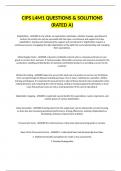CIPS L4M1 QUESTIONS & SOLUTIONS
(RATED A)
Stakeholders - ANSWER In any activity an organization undertakes, whether strategic, operational or
tactical, the activity can only be successful with the input, commitment and support of its key
stakeholders. Gaining and maintaining the support and commitment of stakeholders requires a
continuous process of engaging the right stakeholders at the right time and understanding and managing
their expectations.
Global Supply Chains - ANSWER a dynamic worldwide network when a company purchases or uses
goods or services from overseas. It involves people, information, processes and resources involved in the
production, handling and distribution of materials and finished products or providing a service to the
customer.
Whole Life Costing - ANSWER takes into account the total cost of a product or service over its lifetime,
from concept through to disposal including purchase, hire or lease, maintenance, operation, utilities,
training and disposal. It is important for procurement to take all these elements into consideration when
making decisions and comparing the costs of buying, renting or leasing equipment particularly. In most
cases the purchase costs are only a small proportion of the cost of operating it.
Stakeholder mapping - ANSWER A systematic way to identify the expectations, needs, importance, and
relative power of various stakeholders.
Value Generation - ANSWER Creating value from the supply base can be achieved by not only focusing
on price but also increasing operational performance, driving efficiencies, working collaboratively or
developing continuous improvement activities.
Procurement Cycle - ANSWER the cyclical process of key steps when procuring goods or services.
Steps of the Procurement Cycle - ANSWER 1. Understand Need and develop High level Spec.
2. Market/Commodity and options (inc make or buy assessment).
3. Develop Strategy/plan
, 4. Pre-procurement market test and market engagement.
5. Develop documentation, PPQ/detailed spec/combine with 1.
6. Supplier selection to participate in ITT/RFQ/negotiation.
7. Issue ITT/RFQ.
8. Bid/Tender Evaluation and validation.
9. Contract award and implementation.
10. Warehouse logistics and receipt.
11. Contract performance review and continuous improvement.
12. SRM and SC management and development.
13. Asset management/end of life and lessons learnt.
Contract Management - ANSWER delivers a great amount of data and intelligence that support the
smooth running of a business. Historically, the purpose of a contract as a legal document was to protect
the parties from negative consequences of its breaches. Today, when companies are facing increasing
pressures to reduce costs and improve financial and operational performance, forming and managing
new trading relationships is critical for success. How well an organisation manages its relationships with
partners defines the two core elements of bottom line performance: increasing revenues and decreasing
costs. ... plays an important role by ensuring the smooth running of operations, protecting the
organisation from risks and shaping the buyer-supplier relationships (Aberdeen Group, 2007; Saxena,
2008).
Application of Technology - ANSWER E-Procurement systems can be utilised in the Request for
Information (RFI), Request for Proposal (RFP) and Request for Quotation (RFQ) process as well as for e-
Tendering, e-Auctioning, vendor management, catalogue management, purchase ordering, order status,
shipment status, e-invoicing, e-payment and contract management.
eSourcing / eProcurement systems P2P - ANSWER relates to the electronic procurement of products or
services via the internet. Other systems such as electronic data interchange (EDI) and enterprise
resource planning (ERP) are also forms of...
International Labour Organisation - ANSWER The only tripartite U.N. agency, since 1919 it brings
together governments, employers and workers of 187 member States , to set labour standards, develop
policies and devise programmes promoting decent work for all women and men.
, Supplier evaluation & appraisal - ANSWER is conducted at the tender stage and can be in the form of
either a questionnaire, interview or site visit to assess the supplier's capability in terms of capacity,
financial stability, quality standards, performance and organisational structure and processes in place.
Both existing and potential suppliers are scored on suitability and either approved or rejected to be
added onto the approved supplier list (ASL). This helps to improve existing suppliers performance and
also can periodically ensure you have the right sized and fit of suppliers on you approved list.
Procurement Strategy Development - ANSWER developed in order to establish the direction of how
procurement should be organised in order to implement the procurement policy.
Global Standard for Procurement and Supply - ANSWER is a comprehensive competency framework.
Used by individuals and organisations to enhance performance, the Standard sets the benchmark for
what good looks like in procurement and supply at all levels and across all sectors. It helps individuals to
identify current operating skills and abilities and what is needed to progress.
GDPR - ANSWER General Data Protection Regulation
Sectors of the economy - ANSWER primary, secondary, tertiary
Primary sector - ANSWER extraction of raw materials - mining, fishing and agriculture.
Secondary Sector - ANSWER the part of the economy that transforms raw materials into manufactured
goods
Tertiary Sector - ANSWER concerned with offering intangible goods and services to consumers. This
includes retail, tourism, banking, entertainment and I.T. services.
Procurement - ANSWER total acquisition starting from the identification of a requirement to the disposal
Purchasing - ANSWER is the act
Direct costs - ANSWER Costs that can be specifically identified with a particular project or activity.




